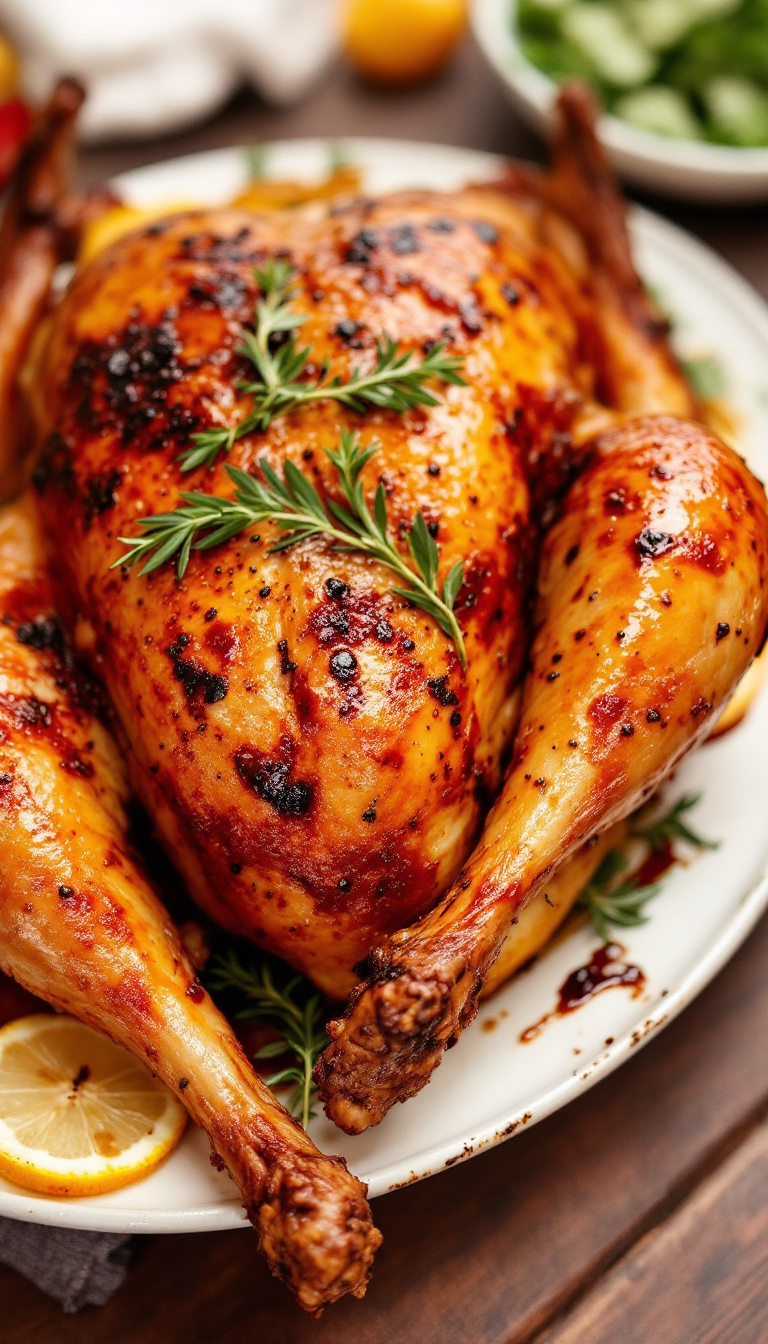
Thanksgiving isn’t just about turkey, it’s about the dance between flavors and memories—kind of like a chaotic family reunion where everything somehow falls into place. Picture this: the turkey, golden and glistening, emerges from the oven like a hero returning from battle. It’s juicy, maybe even a bit rebellious with its spices, ready to steal the show, while whispers of past feasts linger in the air.
Steps
- Thaw the turkey in the refrigerator, allowing 24 hours for every 5 pounds of turkey, and take it out of the fridge an hour before roasting to reach room temperature. Preheat the oven to 325°F and adjust the oven rack so the turkey sits in the center.
- Prepare the herb butter by mixing room temperature butter with minced garlic, salt, pepper, and chopped fresh rosemary, thyme, and sage.
- Remove the turkey from its packaging, discard or set aside the neck and giblets, and pat the turkey dry with paper towels.
- Season the turkey cavity with salt and pepper, then fill it with quartered lemon, onion, apple, and leftover herbs.
- Loosen the skin above the turkey breasts with your fingers and spread a few tablespoons of herb butter underneath.
- Tuck the turkey wings under the body, and place the turkey on a roasting rack inside a pan or on top of chopped vegetables in a disposable pan.
- Soften the remaining herb butter in the microwave and use a brush to coat the turkey’s outside, legs, and wings.
- Roast the turkey at 325°F, allowing 13-15 minutes per pound, until the internal temperature in the thigh and breast reaches 165°F.
- Check the turkey halfway through cooking; once the skin is golden brown, cover the top with foil to protect the breast meat.
- After roasting, let the turkey rest tented with foil for 15 to 40 minutes, and reserve any drippings for making gravy.

Ingredients
- 1 turkey, 12-20 pounds
- 1 onion, peeled and quartered
- 1 lemon, quartered
- 1 apple, quartered
- .75 ounce fresh rosemary
- .75 ounce fresh thyme
- .75 ounce fresh sage
- Butter (for herb butter)
- Minced garlic (for herb butter)
- Salt (for seasoning and herb butter)
- Pepper (for seasoning and herb butter)
- Fresh chopped rosemary, 1 tablespoon (for herb butter)
- Fresh chopped thyme, 1 tablespoon (for herb butter)
- Fresh chopped sage, 0.5 tablespoon (for herb butter)
- 4-5 ribs of celery, roughly chopped
- 4 large carrots, roughly chopped
Nutritional Values
Calories: 5760kcal | Carbohydrates: 30g | Protein: 700g | Fat: 300g | Saturated Fat: 120g | Cholesterol: 2640mg | Sodium: 5180mg | Potassium: 7650mg | Sugar: 10g | Vitamin A: 5650IU | Vitamin C: 54mg | Calcium: 460mg | Iron: 29mg
FAQ
- How much turkey should I buy per person for Thanksgiving dinner?
- It’s recommended to purchase about 1.5 pounds of turkey per person to ensure everyone is well-fed and to have some leftovers. For instance, if you’re serving six people, aim for at least a 10-pound turkey.
- What’s the best way to thaw a frozen turkey?
- Allow one day of thawing in the refrigerator for every five pounds of turkey. It’s a good idea to plan for an additional day just to be safe. Place the turkey on a pan or cookie sheet to catch any drips.
- Should I wash the turkey before cooking it?
- No, washing the turkey in the sink can lead to contamination. Instead, remove the turkey from its packaging and pat it dry with paper towels. The heat from cooking will kill any bacteria.
- Is it necessary to brine or baste the turkey?
- If you have a high-quality store-bought turkey, brining or basting is unnecessary. You can achieve a moist turkey by using an herb butter mixture. Basting requires opening the oven frequently, which can lead to a longer cooking time and potentially dry out the turkey.
- Why shouldn’t I stuff the turkey with dressing?
- Cooking stuffing inside the turkey can result in overcooked meat by the time the stuffing reaches a safe temperature. It’s better to cook stuffing separately in a casserole dish and fill the turkey cavity with flavor-enhancing ingredients like onions, apples, and herbs.
Tips
- Thawing the Turkey: Allocate one day in the refrigerator for every five pounds of turkey to ensure thorough thawing, and consider adding an extra day for safety. Place the turkey on a tray to catch any liquid during defrosting.
- Avoid Washing the Turkey: Skip rinsing the turkey to prevent contamination in your sink. Simply pat it dry with paper towels before preparation, as any bacteria will be eliminated during cooking.
- Use a Thermometer: To confirm that the turkey is properly cooked, use a thermometer to check that the internal temperature has reached 165°F. If it hits 160°F, remove it from the oven and tent with foil to let it rise to the necessary temperature.
- Rest the Turkey: Allow the turkey to rest for at least 15 minutes and up to 40 minutes after cooking. This resting period ensures juicier meat and allows you time to prepare other dishes or make gravy with the drippings.
Equipment
- Meat Thermometer – Essential for accurately determining when the turkey is fully cooked.
- Roasting Rack – Helps elevate the turkey for even cooking, though alternatives like a bed of vegetables are mentioned.
- Basting Brush – Useful for applying the herb butter mixture on the turkey.
- Twine – For tying the turkey legs together.
- Disposable Foil Roasting Pan – If you don’t have a suitable roasting pan at home.
- Large Cutting Board – For carving the turkey after cooking.